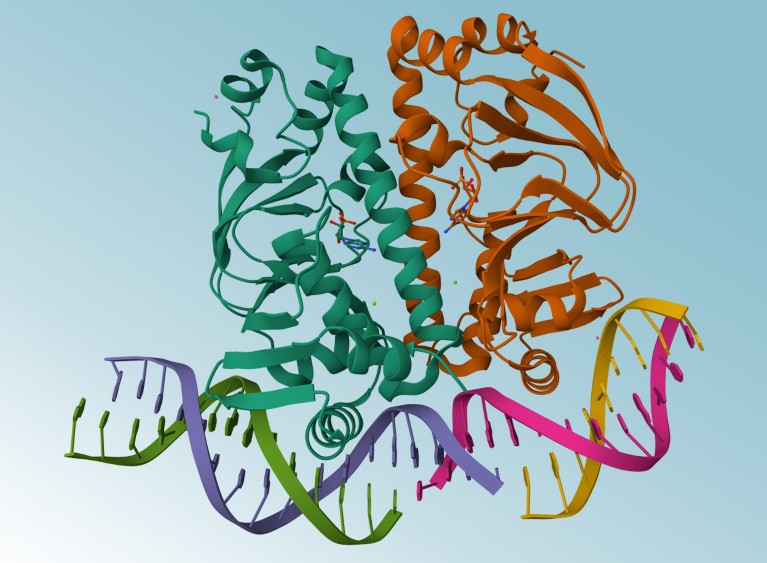Cover image source: Source
TIPAll images linked have been verified to be under Fair Use and allowed to be utilized in this blog.
What is AlphaFold3?
AlphaFold3 represents Google DeepMind’s latest breakthrough in artificial intelligence for molecular biology, advancing our ability to understand and predict how proteins interact with other molecules at the atomic level. At its core, it is a sophisticated deep learning system that combines principles from machine learning, physical chemistry, and structural biology to predict not only protein structures but also their interactions with DNA, RNA, small molecules, and other proteins. Unlike traditional computational approaches that often require extensive computational resources and may take weeks or months to simulate molecular interactions, AlphaFold3 can generate accurate predictions in hours or days, dramatically accelerating research timelines. The system’s architecture builds upon the revolutionary protein structure prediction capabilities of AlphaFold2, but extends far beyond by incorporating advanced attention mechanisms and physics-based potentials that enable it to model the complex dynamics of molecular interactions.
How does AlphaFold3 work?
AlphaFold3 builds on previous versions by adding new capabilities to predict how proteins interact with other molecules. The system uses advanced AI techniques (enhanced attention mechanisms with cross-attention layers between protein and molecule representations) to look at both proteins and molecules simultaneously, helping it understand how they might stick together and interact. I’d explain it as a sophisticated 3D modeling system that can examine molecules from both very close up (atomic level) and farther away (whole protein level), while using AI to learn patterns from existing molecular structures and sequences. What makes AlphaFold3 (as opposed to AlphaFold2) is its ability to not just predict protein shapes, but to understand how they might interact with DNA, drugs, or other proteins, which is crucial for understanding how our cells actually work.
AlphaFold3 works in steps, first looking at the sequence of proteins and searching for similar known structures as templates. It then creates detailed 3D models and repeatedly refines them using both AI predictions and physical chemistry rules about how molecules should behave. The system checks its work by comparing its predictions to known physical laws and calculating confidence scores to tell us how reliable each prediction is. It also considers important factors like energy levels and flexibility when predicting how strongly molecules will bind together, much like predicting how well puzzle pieces will fit together. This is particularly important for drug development, where understanding how a potential drug molecule might bind to a protein target can save years of laboratory testing. The system’s ability to consider factors like water molecules in the environment and the natural flexibility of proteins makes its predictions much more realistic and useful for real-world applications in medicine and biotechnology.
What are the research applications of AlphaFold3?
The potential research applications of AlphaFold3 span diverse fields in biological and medical science. In drug discovery, researchers can utilize its capabilities to predict how potential drug compounds might interact with protein targets, potentially accelerating the development of new therapeutics for diseases ranging from cancer to neurological disorders. In the field of synthetic biology, scientists can leverage AlphaFold3 to design novel proteins with specific binding properties for applications in biotechnology and environmental remediation. For basic research in molecular biology, the system enables detailed investigation of transcription factor-DNA interactions, helping researchers understand the complexities of gene regulation. In structural biology, researchers can use AlphaFold3 to study large macromolecular complexes and their assembly mechanisms and provide information into fundamental cellular processes. The system’s ability to model protein-protein interactions also makes it valuable for studying disease mechanisms, particularly in cases where protein misfolding or abnormal interactions is vital, such as in neurodegenerative diseases like Alzheimer’s and Parkinson’s.
Conclusion
AlphaFold3’s potential to transform healthcare and solve real-world problems is quite frankly, really cool. By accurately predicting how proteins interact with potential drug molecules, it could dramatically speed up the development of new treatments for devastating diseases like cancer, Alzheimer’s, and rare genetic disorders, potentially bringing life-saving medications to patients years faster than traditional methods. Beyond medicine, this technology could help design proteins to tackle environmental problems. Perhaps AlphaFold3 engineers proteins that help break down plastic pollution, capture carbon from the atmosphere, or create more sustainable biofuels. Most importantly, by making this powerful tool freely available to academic researchers worldwide (which I believe was recent after backlash), AlphaFold3 puts cutting-edge technology in the hands of scientists everywhere, from small universities to major research centers, ensuring that brilliant minds around the globe can contribute to solving humanity’s biggest challenges.
CitationsI’ve listed below some articles that I’ve cited. For more context, I would highly recommend you peruse through them!
AlphaFold 3 predicts the structure and interactions of all of life’s molecules. (2024, May 8). Google. https://blog.google/technology/ai/google-deepmind-isomorphic-alphafold-3-ai-model/
Callaway, E. (2024). AI protein-prediction tool AlphaFold3 is now open source. Nature. https://doi.org/10.1038/d41586-024-03708-4
Jumper, J., Evans, R., Pritzel, A., Green, T., Figurnov, M., Ronneberger, O., Tunyasuvunakool, K., Bates, R., Žídek, A., Potapenko, A., Bridgland, A., Meyer, C., Kohl, S. A. A., Ballard, A. J., Cowie, A., Romera-Paredes, B., Nikolov, S., Jain, R., Adler, J., … Hassabis, D. (2021). Highly accurate protein structure prediction with AlphaFold. Nature, 596(7873), 583–589. https://doi.org/10.1038/s41586-021-03819-2

